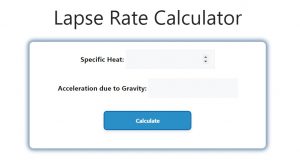About Lapse Rate Calculator (Formula)
The Lapse Rate Calculator is a valuable tool for meteorologists, geologists, and environmental scientists to understand how temperature changes with altitude in the atmosphere. The lapse rate is crucial in various applications, including weather prediction, climate studies, and environmental assessments. By calculating the lapse rate, you can determine how quickly the temperature drops as you ascend into the atmosphere, providing insight into atmospheric stability and potential weather patterns.
Formula
The formula for calculating the lapse rate is:
Lapse Rate = g / Cp
Where:
- g represents the acceleration due to gravity (approximately 9.81 m/s²).
- Cp is the specific heat capacity of air at constant pressure (approximately 1005 J/kg·K).
How to Use
- Determine the Required Values:
- Use the standard values for gravity (g) and the specific heat capacity of air (Cp), or insert specific measurements if available.
- Apply the Formula:
- Plug the values into the formula to calculate the lapse rate.
- Interpret the Results:
- Analyze the calculated lapse rate to understand how temperature changes with altitude in a specific location or scenario.
Example
Let’s illustrate how to use the Lapse Rate Calculator with a practical example.
Given Data:
- g = 9.81 m/s² (standard gravity)
- Cp = 1005 J/kg·K (specific heat capacity of air)
Step 1: Apply the Formula
Lapse Rate = g / Cp
Lapse Rate = 9.81 / 1005 ≈ 0.00975 K/m
Step 2: Interpretation
A lapse rate of approximately 0.00975 K/m indicates that the temperature decreases by about 0.00975 degrees Celsius for every meter of altitude gained.

FAQs
- What is the lapse rate?
The lapse rate is the rate at which atmospheric temperature decreases with an increase in altitude. - Why is the lapse rate important?
Understanding the lapse rate is crucial for meteorology, aviation, and environmental science, as it helps predict weather patterns and assess atmospheric stability. - What are the different types of lapse rates?
There are several types, including the environmental lapse rate, dry adiabatic lapse rate, and moist adiabatic lapse rate. - How is the environmental lapse rate different from the dry adiabatic lapse rate?
The environmental lapse rate is the actual rate of temperature decrease with altitude, while the dry adiabatic lapse rate is a theoretical value assuming no heat exchange. - How does humidity affect the lapse rate?
High humidity generally leads to a lower lapse rate because moist air has a higher specific heat capacity, resulting in slower temperature decreases with altitude. - What is the standard value for Cp?
The standard value for the specific heat capacity of air at constant pressure (Cp) is approximately 1005 J/kg·K. - How do I convert lapse rate from K/m to °C/m?
The lapse rate in K/m is numerically equivalent to °C/m since they are both measuring temperature change per unit altitude. - Can the lapse rate be negative?
Yes, a negative lapse rate indicates that the temperature increases with altitude, which can occur in temperature inversions. - What is the significance of a high lapse rate?
A high lapse rate often indicates unstable atmospheric conditions, which can lead to thunderstorms or severe weather. - Is the lapse rate the same everywhere?
No, the lapse rate can vary based on location, time of year, and atmospheric conditions. - How does altitude affect the lapse rate?
As altitude increases, the lapse rate can change due to variations in atmospheric pressure and temperature. - What are the implications of lapse rate in aviation?
Pilots use lapse rates to understand weather conditions and make informed decisions about flight paths and altitudes. - Can the lapse rate help in climate modeling?
Yes, accurate lapse rate calculations are essential for climate models to predict temperature changes under different scenarios. - What role does the lapse rate play in weather forecasting?
It helps meteorologists predict cloud formation, precipitation, and storm development based on temperature changes with altitude. - How can I measure the lapse rate at a specific location?
You can measure the lapse rate using weather balloons or data from weather stations that provide temperature readings at various altitudes. - What happens during a temperature inversion?
Inversions occur when the lapse rate is negative, leading to warmer air trapped above cooler air, which can affect air quality and weather. - Does the lapse rate remain constant?
No, the lapse rate can change due to various atmospheric factors, including humidity and pressure changes. - How does the lapse rate impact ecosystems?
Different lapse rates can affect local climates, influencing ecosystems and biodiversity in various regions. - What is the role of the lapse rate in geothermal energy?
Understanding lapse rates can help assess temperature gradients in geothermal fields for energy extraction. - Where can I find more resources about lapse rates and atmospheric science?
You can explore meteorology textbooks, academic journals, and online resources dedicated to atmospheric science for further information.
Conclusion
The Lapse Rate Calculator is an essential tool for understanding how temperature changes with altitude, providing valuable insights for various scientific fields. By utilizing this calculator, you can better grasp the complexities of atmospheric behavior, aiding in weather prediction, climate modeling, and environmental assessment. Regularly monitoring and understanding the lapse rate can help you stay informed about atmospheric conditions and their potential impact on weather patterns and ecosystems.